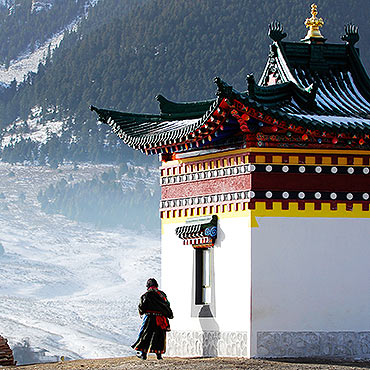
Buddhism in China is woven into the country’s rich history and culture. This interconnectedness makes it virtually impossible to complete your travels without gaining some perspective and understanding of how this religion has impacted the life, spiritual pursuits, philosophy, and learnings of Chinese people for thousands of years.
While the origins of Buddhism in China have long been debated, there is a general consensus that it is part of the country’s cultural fabric, having survived the impact of competing ideologies such as Confucianism, Taoism, and Mahayana Buddhism throughout the many dynasties.
At its heart, Buddhism values enlightenment of the human soul and morality. Buddhist believers practise discovering the truth of life and the universe in accordance with the methods practised by Siddhartha, the founder of Buddhism, and a prince of Kapilavastu. The ultimate goal is to transcend life, death, and suffering.
Historians believe that Buddhism reached China in the north via the ancient Silk Road of Northwest India. It is believed to have also reached China’s shores in the south coming across the sea.
Buddhism in China differs from Indian cultural traditions, although the translation of Indian Buddhist scriptures began as soon as these arrived in China. These were embraced by Chinese Buddhist monks who learned the scriptures and became responsible for search, interpretation and teaching to the people. Chinese translation of Buddhist scriptures is said to be the most comprehensive, systematic, and complete, and it’s not hard to see why when you discover the proliferation of temples, statues, and more, which are evidence of the deep impact of Buddhism on Chinese culture.
A visit to China will reveal the connections in many ways. Pagodas, temples, caves, statues, scriptures, precious objects, art, and music have all been influenced and created in reverence to Buddhism in China. In fact, there is an overwhelming number in every destination that it can be very difficult for outsiders to understand the relevance and significance.
One distinct difference between Buddhism in China and its original teachings is that Buddha is both a god to be prayed to, as well as a spiritual teacher. The popularity of Buddhism over Confucianism and Taoism is its emphasis on karma and reincarnation. That said, there was a convergence of all three such that visitors will find some shrines allow for the worship of all three. Major sects within Buddhism in China include Chan (or Zen) school, which became known for its less orthodox methods of teaching and the way it made enlightenment more accessible to common people; Tiantai; and Pure Land Buddhism. The Mahayana school of Buddhism is by far and away from the most prominent in China today.
Visit the highlights of Buddhism in China
Having infiltrated so much of China’s history, it’s difficult to distill the highlights of Buddhism in China for a western traveler. Whether you’re planning a first time or you’ve enjoyed multiple trips to China, there is no doubt you’ll feel drawn to every corner of the country. So, to make things easier (or maybe it makes things harder!), we’ve put together our list of must-see Buddhist highlights for western travelers in China.
White Horse Temple, Luoyang

Considered “the cradle of Chinese Buddhism”, White Horse Temple was the first temple established in China in 68 AD at the time of Emperor Ming of the Han dynasty. The significance of the temple has been preserved and renovated, along with the original stone statues that give the temple its name and many of the glorious halls and gardens can be found in this fascinating complex.
Leshan Giant Buddha, Leshan

From every perspective, you will be amazed at the scale and craftsmanship of the world’s largest and tallest stone Buddha statue, carved into the sandstone cliff where the Min, Qingyi and Dadu rivers come together. From the water, it appears awesome and from the top, you’ll appreciate the intricacies of the carving as well as the beauty and significance of the amazing natural site directly facing Mt Emei near Chengdu. Built over 1200 years ago and taking 90 years to complete, this giant Buddha statue towers 71 meters above the rivers. Breathtaking!
Big Wild Goose Pagoda, Xi’an

Every child growing up in China knows Monkey King, and not surprisingly, so do many people from all over the world. What you may not know is the connection between Monkey King and the Big Wild Goose Pagoda in Xi’an. Construction of the pagoda was suggested by none other than Master Xuanzang whose adventures were captured in the classic Chinese novel Journey to the West. Master Xuanzang traveled to India to learn Buddhism and it was on this journey he found three disciples, one of whom was Monkey King. Master Xuanzang also returned from these travels with over 600 Buddhist scriptures which he diligently translated. These Buddhist scriptures and treasures were stored in none other than the Big Wild Goose Pagoda with construction commencing in 652AD. And while earthquakes, groundwater, and age have contributed to a definite lean that is apparent in the pagoda, it continues to be a Xi’an must-see highlight (even though it’s undergone reconstruction several times since).
Longmen Grottoes, Luoyang

Be amazed at the number, scale and wonder of some of the finest examples of Chinese Buddhist art to be found in caves excavated from limestone cliffs, located in an area of scenic natural environment. At the Longmen Grottoes you will marvel at the sheer number and artistry of the exquisite collection of over a remarkable 100,000 Buddhist sculptures scattered over thousands of large and small caves, covering an extensive area. The smallest statue is tinier than a finger – the largest ten times human size. Hear from your guide the stories behind the development, destruction and conservation of the grottoes.
Shaolin Temple, Dengfeng

Feel the history of China and Zen Buddhism evident in the multiple halls and building clusters comprising the temple buildings, first established in the 5th century when the first Indian master brought the religion to China. Even the martial arts for which monks have become famous have an evolving story. Shaolin Temple is home to the legendary Chinese Kung Fu and Chinese Zen Buddhism. Enter through the grand white gate carrying an inscription from Emperor Kangxi to view the many temple halls with their inner decorations. Just as amazing is the extensive pagoda forest – tombs commemorating monks revered over different dynasties.
Mogao Caves, Dunhuang

Boasting over 700 caves, 2,000 painted statues, and 40 thousand square meters of mural paintings, the Mogao Grottoes are spectacular on another level. Frequently referred to as the Thousand Buddha Grottoes or Caves of the Thousand Buddhas, the thousands of carvings found here have survived centuries – a marvel in itself – and a visit will inspire awe and wonder.
Potala Palace, Lhasa

A magnificent icon of Tibet, visiting Potala Palace will be a travel memory you’ll always treasure. Apart from its status as a surprising exemplar of architectural design, Potala Palace is a place where reverence meets wonder. Both pilgrims and travelers alike sense how special it is, regardless of their origins. Formerly the residence of the Dalai Lama, you’ll discover the history behind this sacred, mysterious palace, which dates back to the 7th century. There’s no question about its inclusion on the list of best places to visit in China.
Po Lin Monastery and The Big Buddha, Hong Kong

Relatively young by China’s standards, Po Lin Monastery is a Buddhist monastery that was originally known as ‘Big Thatched Hut’ when it was first established on Lantau Island over 100 years ago. The monastery is a place of tranquility and serenity, while the monks who live there – remain committed to creating a place where they can practise and spread Dharma. The Big Buddha Statue – also known as the Tian Tan Buddha – sits at the front of the monastery. It is the second largest outdoor Buddha statue in the world. At 34 meters in height and weighing just over 200 tonnes, locals and visitors alike visit here in reverence – and we feel sure you will too.
Drepung Monastery, Lhasa

Be honored visiting the center of learning and one of the most sacred monasteries in Tibet, regarded as analogous with the Sorbonne or Oxford. Around 300 monks study at the center. The biggest event is the giant thangka unveiling of Buddha’s picture during the Shoton Festival.
Lama Temple, Beijing

Yonghe Temple, also known as the Lama Temple, is a functioning Tibetan Buddhist temple with its art treasures that has survived many changes to survive to today when it is a popular site for locals and visitors alike. The fact the monastery is still operating is all the more remarkable for the fact that construction commenced centuries ago in 1694 during the Qing dynasty when it was built as the residence of Prince Yong who later became Yongzheng Emperor. In 1725, it was converted to a temporary imperial palace called Yonghe Palace.
In 1711, Qianlong Emperor, the fourth son of the Yongzheng Emperor, was born in this building. Because two emperors were associated with location, it was considered most auspicious and regarded as a ‘blessed land that gives birth to emperors’. As such, it acquired the rights to use yellow glazed tiles and red walls, just as is used at the Forbidden City. In 1744, it was converted to a lamasery by the edict of the Qianlong Emperor and then became the administrative center of Tibetan Buddhism. The building is considered the perfect fusion of Han (Chinese) Buddhism and Tibetan Buddhism, through the style of buildings and artworks. Today, a continuous stream of worshippers and pilgrims visit the temple, especially on the first day of Chinese New Year. The famous cham dance by the monks of Yonghe temple during the Dharma Assembly (usually held in the last week of the first lunar month and lasts 8 days) is the main highlight of this temple.
Lingyin Temple, Hangzhou

With a history of almost 1,700 years, Lingyin Temple is one of the ten famous Chan Buddhist temples in China. The original founder was an Indian monk, Huili, who traveled from middle China to Hangzhou in 326 AD. It is one of the wealthiest temples in China and features numerous pagodas, grottoes, and religious carvings, many dating back to an era of prosperity nearly two millennia previously when thousands of monks were housed there. Lingyin Temple stands on the northwestern corner of West Lake and has been rebuilt many times during its history. It is now regarded as one of the most important Buddhist temples, appealing to pilgrims and travelers alike. The practice of Kau Chim (a fortune telling practice, also known as Chinese Fortune Sticks) conducted in Lingyin Temple is very popular and held in great regard among locals and visitors.
A final word on Buddhism in China
So there you have it. A bucket list of Buddhism in China highlights, which can be found in virtually every corner of the country. If you’re thinking this is exactly the kind of cultural experience you want to include in your travels, be sure to speak with a China travel specialist who can help you understand how to make the most of your valuable time while you’re in-country. We have a dedicated team of consultants whose job is to craft and design the kind of tour you’ll savor long after arriving home.
Fascinated by China and its rich cultural history, including Buddhism? Why not make your curiosity a feature of your travel in China. Join a fully guided multi-day small group or private tour. Our team of travel consultants can advise on enriching activities like visiting the numerous Buddhist highlights in China to be found throughout the country. Ready to make beautiful travel memories on your China vacation? We’re here to help!




 Terracota Army
Terracota Army





